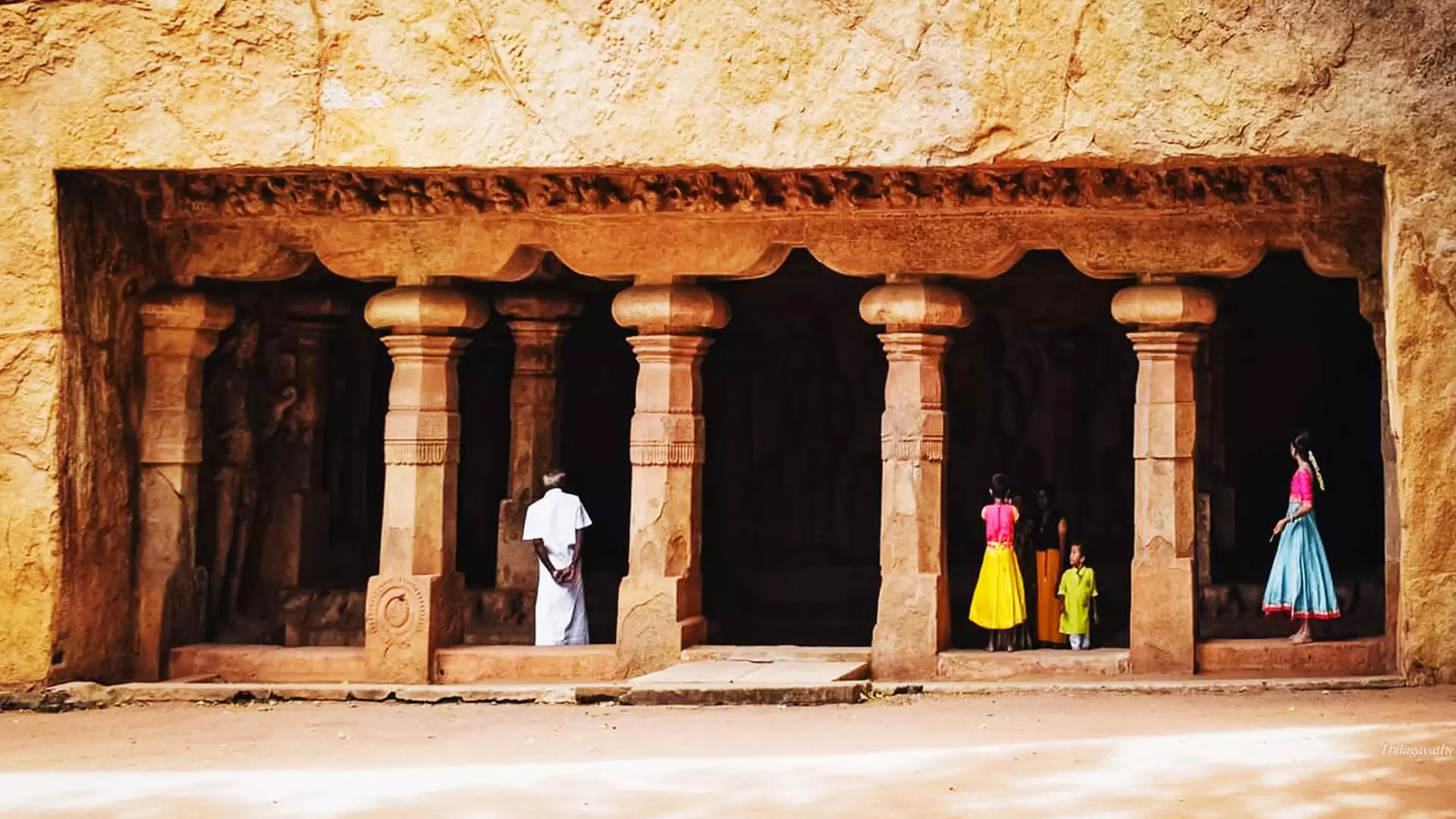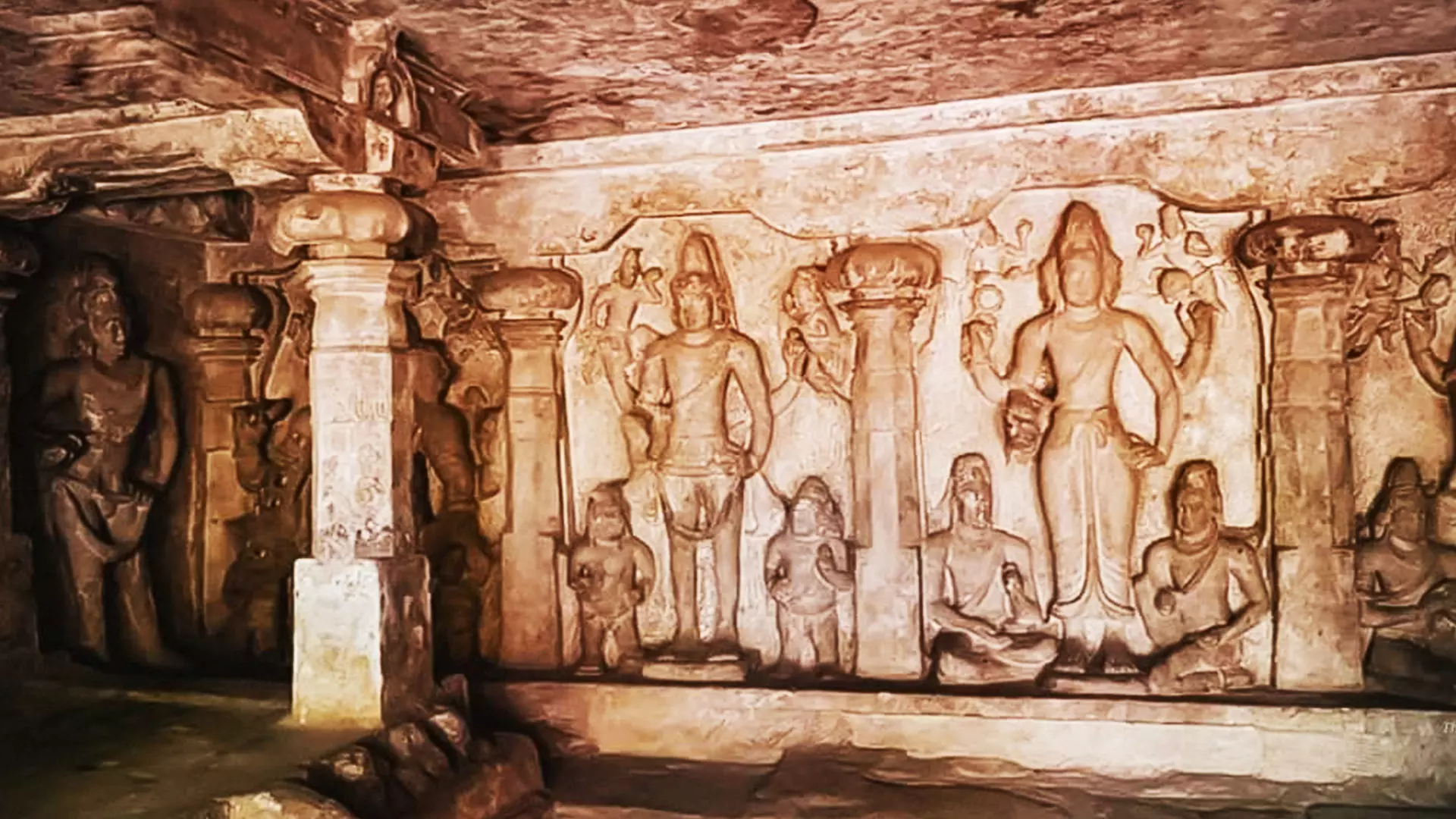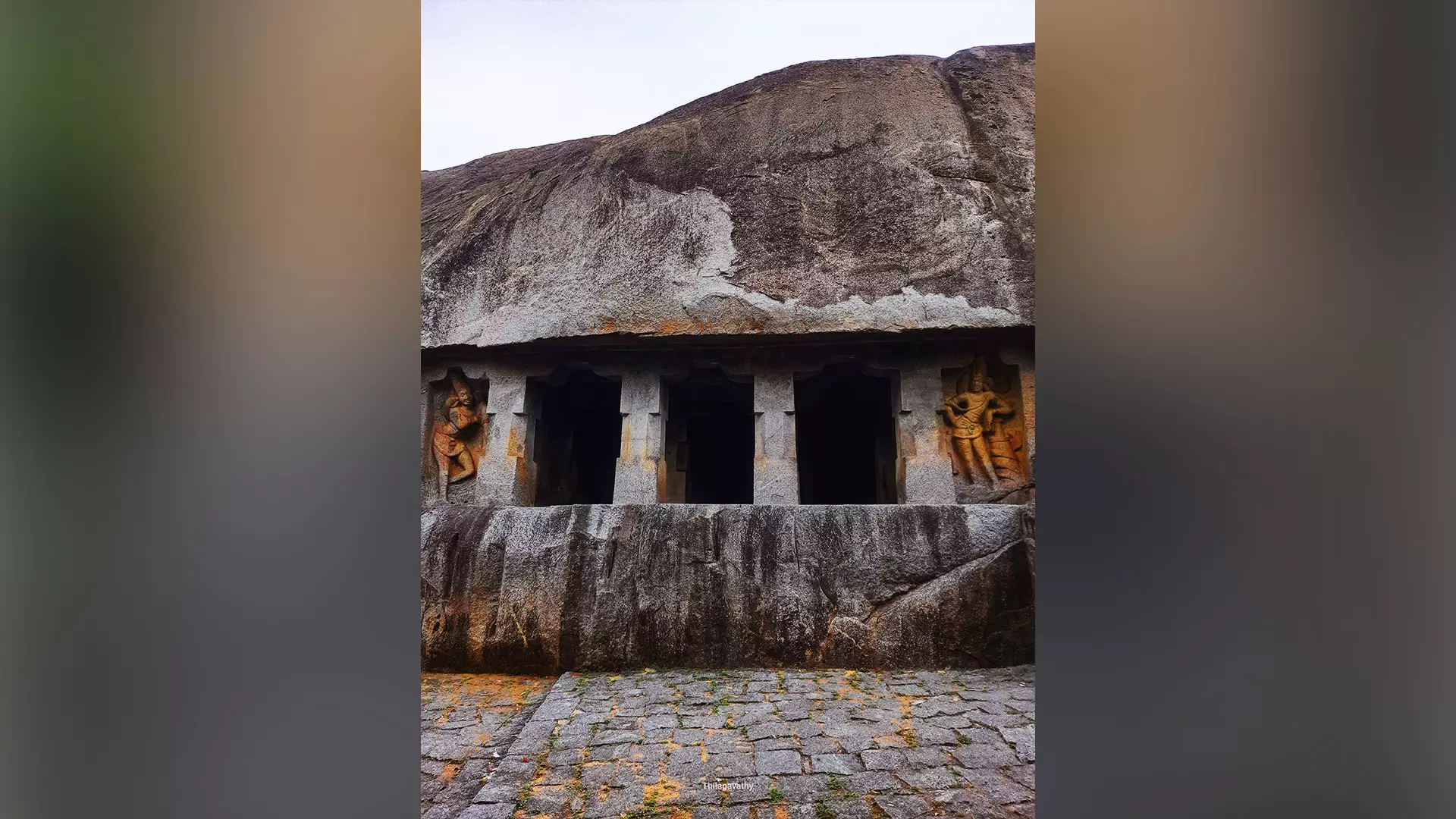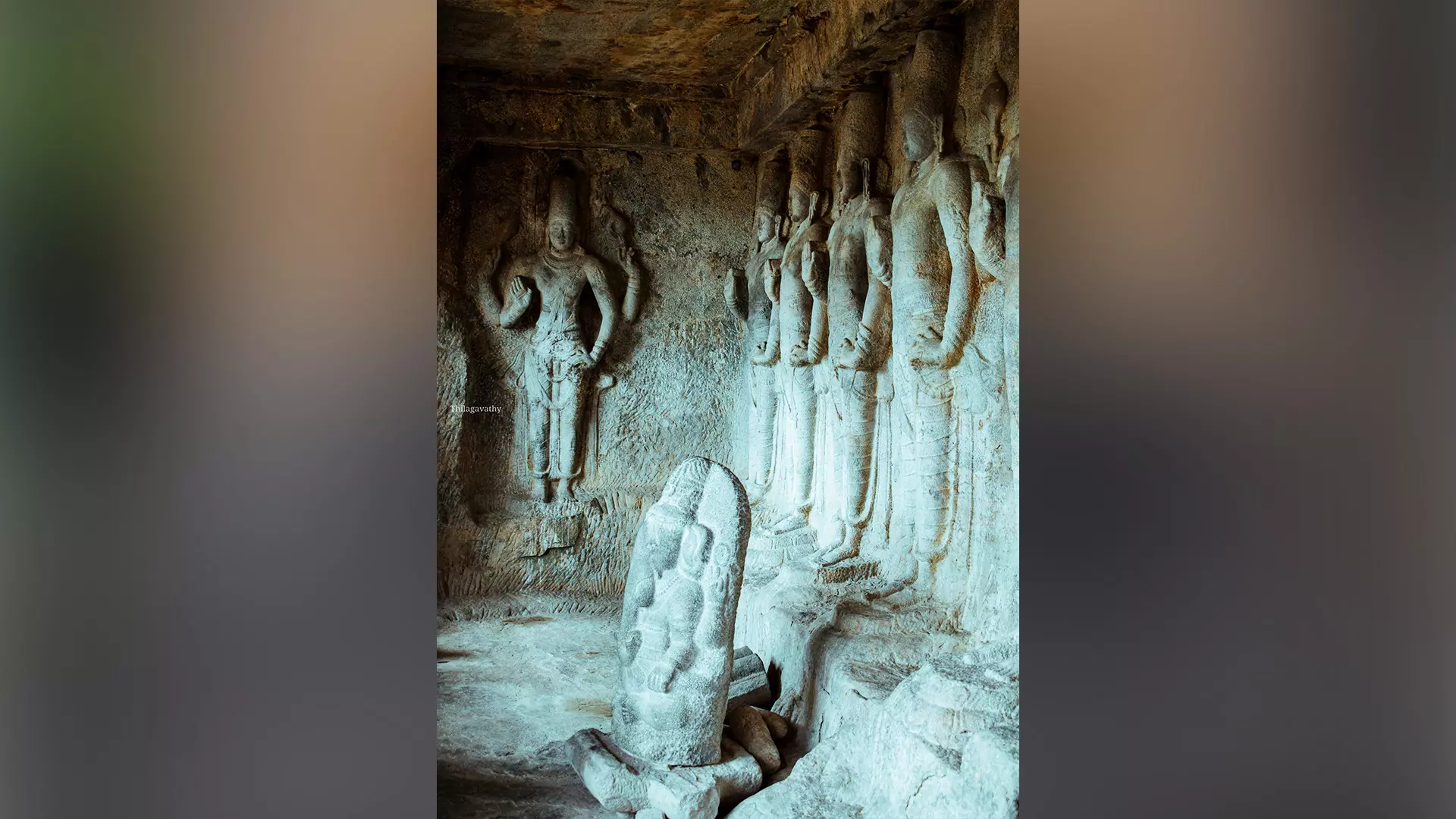
- Home
- India
- World
- Premium
- THE FEDERAL SPECIAL
- Analysis
- States
- Perspective
- Videos
- Sports
- Education
- Entertainment
- Elections
- Features
- Health
- Business
- Series
- In memoriam: Sheikh Mujibur Rahman
- Bishnoi's Men
- NEET TANGLE
- Economy Series
- Earth Day
- Kashmir’s Frozen Turbulence
- India@75
- The legend of Ramjanmabhoomi
- Liberalisation@30
- How to tame a dragon
- Celebrating biodiversity
- Farm Matters
- 50 days of solitude
- Bringing Migrants Home
- Budget 2020
- Jharkhand Votes
- The Federal Investigates
- The Federal Impact
- Vanishing Sand
- Gandhi @ 150
- Andhra Today
- Field report
- Operation Gulmarg
- Pandemic @1 Mn in India
- The Federal Year-End
- The Zero Year
- Science
- Brand studio
- Newsletter
- Elections 2024
- Events
How a 34-year-old woman travelled alone to document 119 rock-cut temples of Tamil Nadu

A digital camera that her husband gifted her on her birthday, a couple of lenses, a notebook and a bottle of water… Thilagavathy’s backpack is not heavy as she has to return home after visiting each rock-cut temple. A couple of years ago, she told her husband that she wanted to document all the rock-cut temples in Tamil Nadu. He supported his wife, a mother of two, but with a...
A digital camera that her husband gifted her on her birthday, a couple of lenses, a notebook and a bottle of water… Thilagavathy’s backpack is not heavy as she has to return home after visiting each rock-cut temple. A couple of years ago, she told her husband that she wanted to document all the rock-cut temples in Tamil Nadu. He supported his wife, a mother of two, but with a condition. Knowing the remoteness of the location in which many rock-cut temples in Tamil Nadu are situated, he told Thilagavathy not to stay anywhere in the night and return home as early as possible.
The journey in search of rock-cut temples that Thilagavathy started in 2022 ended in September with a unique feat: She was able to take photographs of all the 119 rock-cut temples and structures in Tamil Nadu, travelling alone across the state. If you are familiar with the geography of Tamil Nadu, you will know how difficult it is to reach the rock-cut temples of which most are situated in the remote pockets and hills. It was challenging but there existed a connection, according to her, that eventually led her from one rock-cut to the other. Even though there are innumerable studies on the rock-cut temples of Tamil Nadu, no one has so far photographed the entire structures the way Thilagavathy did. With a long list of 119 rock-cut structures and more than 1,700 photographs, Thilagavathy is planning to bring out a coffee-table book with the help of a leading publisher.

Keezh Kudavarai, a rock-cut marvel in Trichy.
Being a wife and a mother of two children, it was difficult for Thilagavathy to make solo trips to the temples. “I normally catch the night train to my destination. I will travel the whole night and reach the place the next morning. I will be visiting the rock-cut temple during the day. After taking photographs of the temple, I roam around the area a little to get the feel of the place. There will be many rock-cut temples and structures in some places so I plan it accordingly. I take the night train to return home,” said Thilagavathy. When she was away, her husband took care of their children.
Travelling alone to the temples in the remote areas was always challenging. “What is this girl going to do on top of the hill?”, the vandals would ask her. “In most cases, I didn't get a mode of transport once I got down at the railway station or bus stand. I had to trek four or five kilometres in the scorching sun to reach the temple,” she said.

Inside view of Keezh Kudavarai.
When she walked into a rock-cut temple, she saw four people sitting at the entrance and having beer. “A middle-aged man in the group came forward and asked me what I wanted. He was rude and didn’t allow me to take photographs. When I tried to call my husband over the phone, he got a bit worried and soon left the scene,” said Thilagavathy. Strangers following her at the remote site was common and once she complained to the police and they saved her. Once she left her camera bag with two lenses outside a temple and went inside to take photographs. A perfect day light gave her a dozen nice pictures but when she came out she found both her lenses missing.
A native of Arakkonam, Thilagavathy got married when she was 18, and then settled down in Erode with her husband. She developed a passion for photography after seeing the photographs taken by her brother Thiyagarajan, a talented photographer-artist who died in an accident in 2018. When she first saw the photographs taken by her brother, they took her to a different world, of trees, rivers, birds, and ancient monuments.
She would look at those photographs and wonder about the magic of keeping something alive in memory forever. She wanted to continue photography as a tribute to her brother. She started her initial experiment in photography with her smartphone. She started taking pictures of everything under the sun and started uploading them on a social networking site. With the advancement of technology, there were many doing the same thing like her. There was no fun so she decided to think big.

Mandakapattu, the oldest rock-cut temple in Tamil Nadu.
“I was always interested in history. While reading an article in a Tamil magazine, I got to know about some ancient rock-cut temples in Tamil Nadu. The architectural beauty of these rock-cut cave structures fascinated me. When I started searching for them online, I didn’t get even the basic information about many. It disappointed me. I decided to document these temples to create awareness about the ancient architectural marvels, of which many are hidden and unknown due to lack of care and awareness,” said Thilagavathy.
Although the tradition and technique of rock-cut temple architecture in India started during the time of Asoka (3rd century BC) in and around ancient Magada and spread widely over the Western part of India, it took a long time to reach the southern parts of today’s India. Built by Pallava king Mahendravarman-1 (AD 600-630), the Mandagapattu rock-cut temple in Villupuram district is considered one of the oldest of this kind in Tamil Nadu. The rock-cut projects are mainly the petrified versions of the contemporary brick-and-timber or the humble wattle mud-and-thatched structure, according to D Dayalan, former director of the Archaeological Survey of India (ASI). “The rock-architecture of Tamil Nadu and Kerala starts with cut-in temples, familiarly called the rock-cut cave-temples. The early cave-temples are simpler with short, massive and square pillars on the facade with a heavy corbel or potika,” writes D Dayalan in Cave-temples in the regions of the Pandya, Muttaraiya, Atiyaman and Ay dynasties in Tamil Nadu and Kerala.

Inside the Narthamalai cave temple in Pudukkottai district.
Majority of the cave-temples in Tamil Nadu and Kerala, according to him, are excavated into the harder and less tractable rocks such as granite, charnockite and gneiss as opposed to the cave-temples in Karnataka, Andhra Pradesh and Maharashtra, where the cave-temples were excavated into a much softer and more tractable stones such as sandstone, khondalite, schist, Deccan trap etc. Even though rock-cut temples have a long history, many temples constructed using bricks later became popular due to various cultural and social shifts. In Tamil Nadu, only scholars and heritage enthusiasts walk towards these temples.
“It took almost two years for me to cover all the 119 rock-cut temples and structures. While climbing the hills, I struggled because of varicose veins on my right leg. There were days when I stopped my trek halfway and cried. But I could overcome all those hurdles because each trip was a learning session,” said Thilagavathy, whose first trip was to Keezhkudavarai, a beautiful rock-cut cave temple inside the Rock Fort in Trichy.
The rock -cut temples of Mamallapuram, Trichy, Mandagapattu, Pillyarpatti, Pudukkottai, Sittanavasal, Kazhugumalai and Chithral are some of the most fascinating ones according to her. Thilagavathy has spent more than one lakh rupees for her rock-art documentation project so far. “I have more than 1700 photographs of the rock-cut temples and structures, which I want to use for creating awareness among people about the significance of these architectural wonders. I am happy that I have documented all the cave temples and structures and they will be passed on to the next generation,” she added.
